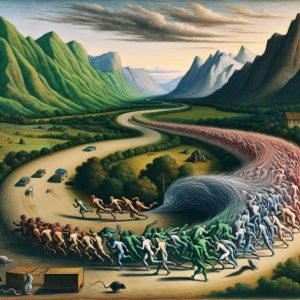
Countdown to Crisis: The Stock Market Crash and the Great Depression
March 28, 2024
Few events in financial history have been dissected as thoroughly as the stock market crash 1929 and the subsequent Great Depression. Yet, despite the wealth of analysis, the intricate web of causes and effects remains a subject of fascination and study. As a financial analyst with a keen understanding of mass psychology, I invite you to delve into a refined compendium of factors that contributed to these seismic events in economic history.
The Roaring Twenties and the Prelude to Despair
The Roaring Twenties, an era synonymous with jazz, flappers, and speakeasies, also profoundly transformed the financial sector. As a critical factor that contributed to the stock market crash and the Great Depression, the detachment of stock prices from economic reality during this period warrants a closer examination. The stock market became a playground for the masses, with many Americans investing heavily in stocks for the first time. This mass participation was partly due to the proliferation of investment trusts, which promised to democratize wealth and make the stock market accessible to the average person.
However, these investment trusts often lacked transparency and were overleveraged, creating a precarious house of cards. As stocks climbed, the value of these trusts ballooned, convincing more people to invest. By 1929, the market capitalization of these trusts exceeded the entire value of the bank deposits in the United States, a clear indication of the speculative excess that had taken hold.
The speculative frenzy was not limited to the inexperienced. Seasoned business people and financial professionals were equally captivated by the potential for quick profits. In one historical instance, a group of leading bankers, known as the “Pool Operators,” would collaborate to inflate the price of a stock by manipulating its demand and then selling it at a premium. This practice was legal at the time.
The expansive use of credit was another pivotal factor that contributed to the stock market crash and the Great Depression—buying on margin allowed investors to borrow up to 90% of the stock’s value. When the market turned, these margin calls could not be met, leading to forced sales and a downward spiral in stock prices. An example of this can be seen in the infamous collapse of the Radio Corporation of America (RCA) stock, which had become a favourite among speculators. RCA shares plummeted from a high of $505 to less than $10 following the crash, devastating the portfolios of many investors who had purchased on margin.
The speculative bubble of the Roaring Twenties, exacerbated by easy credit and unchecked optimism, created an environment ripe for a correction. The consequences were catastrophic when the market finally faltered, leading to a chain reaction culminating in the Great Depression. It was a stark reminder that the fallout can be far-reaching and severe when speculation overrides sound financial principles.
Mass Psychology and Market Mania
As a financial analyst, it is imperative to understand investors’ collective behaviour. The stock market reflects economic indicators and is also a barometer of human psychology. The boom of the 1920s was propelled by a mass belief in the continued upward trajectory of stock prices—a belief bolstered by the herd mentality.
Investors, driven by a fear of missing out, poured their savings into the stock market, often with little understanding of the investments they were making. This herd behaviour created an economic bubble, a deviation from rational investment strategies that was destined to burst.
The Tipping Point: Black Tuesday and Beyond
Black Tuesday marked an outcome in a series of downturns that had begun in late October, each a significant factor contributing to the stock market crash and the Great Depression. The market was shaky in the weeks preceding Black Tuesday, with the Dow Jones Industrial Average fluctuating wildly. Investors were already feeling uneasy due to previous days of losses, including the significant plunge on October 24, 1929, known as Black Thursday.
On that fateful day of October 29, 1929, a staggering 16 million shares were traded—a record number that would stand for nearly four decades. The panic selling was relentless as investors realized the speculative bubble had burst. The market’s infrastructure was overwhelmed by the volume of trades, and the ticker tape, running hours late, only added to the chaos and fear.
One historical example that illustrates the scale of the disaster is the case of the steel magnate Charles Schwab, who had invested heavily in the market. Schwab saw his fortunes decimated by the crash, a fate shared by many industrialists of the era. The catastrophic losses were not confined to the rich; they rippled throughout the economy. Banks, which had invested depositors’ money in the stock market, found themselves on the verge of collapse as the value of their assets disintegrated.
The immediate aftermath was devastating. Fortunes disappeared overnight, wiping out the savings of countless Americans. The unemployment rate began skyrocketing as businesses failed and banks closed their doors. This economic turmoil laid the groundwork for the Great Depression, a widespread poverty and hardship that would last well into the 1930s. The stock market crash became a pivotal factor that contributed to the crash and the Great Depression, serving as a stark reminder of the vulnerability of the financial system and the repercussions of unchecked speculation.
Contrarian Investing: The Lone Voices of Dissent
The contrarian investors of the 1920s, a critical factor that contributed to the stock market crash and the Great Depression, serve as a historical testament to the value of dissenting from prevailing market euphoria. Amongst these was the famed economist Roger Babson, who consistently warned against the overheated stock market, predicting that a crash was inevitable. In September 1929, he famously stated, “Sooner or later, a crash is coming, and it may be terrific.” Babson’s perspective was grounded in economic indicators that he believed signalled an unsustainable bubble.
Another notable contrarian was Joseph P. Kennedy, patriarch of the Kennedy clan, who purportedly exited the stock market after receiving stock tips from a shoeshine boy—a sign to him that speculation had reached unsustainable levels. Before the crash, his move to divest from the market preserved his family’s wealth and positioned him for future success.
These contrarian investors relied on careful analysis and instinct, often challenging the rosy outlooks of their contemporaries. Their ability to remain detached from the crowd’s enthusiasm allowed them to identify risks others overlooked. They avoided catastrophic financial losses by trusting their assessment of the prevailing sentiment.
The strategies and mindset of these contrarians highlight a fundamental principle of investing: the market can be wrong, and the majority opinion is not always correct. Their actions provide a blueprint for modern investors, emphasizing the need for rigorous analysis and the courage to act against the tide. As history shows, these lone voices of dissent can be a pivotal factor contributing to an investment strategy’s success or failure, particularly during times of market turmoil like the stock market crash and the Great Depression.
The Aftermath and Echoes in Modern Times
The Great Depression fundamentally altered the American landscape, reshaping government policy and financial regulations. One pivotal factor contributing to the stock market crash and the Great Depression was insufficient regulatory mechanisms. This led to establishing the Securities and Exchange Commission (SEC) in 1934 to restore investor confidence and ensure fair practices in the securities markets. This historic reform aimed to prevent rampant speculation from exacerbating the market’s downfall.
Furthermore, the economic devastation of the 1930s spurred the creation of the Social Security Act, which provided a safety net for the elderly and unemployed for the first time in U.S. history. These measures reflect a shift towards a more interventionist role for the government in economic matters, a legacy that continues to influence policy debates today.
Present-day market fluctuations often invoke comparisons to the pre-Depression era, reminding investors and regulators alike of the importance of vigilance against speculative excesses. The lessons learned from that period continue to echo, serving as cautionary tales that underscore the need for prudent economic stewardship. Understanding the factors that contributed to the stock market crash and the Great Depression remains a crucial aspect of crafting sound financial strategies and policies to safeguard against similar crises in the future.
Conclusion
In conclusion, the cataclysmic events of the stock market crash and the Great Depression came from a complex interplay of various elements. These ranged from excessive speculation, inadequate regulation, and overleveraging in the financial markets to widespread economic misunderstandings and flawed monetary policies. One such example is the Smoot-Hawley Tariff Act of 1930, which arguably exacerbated the Depression by stifling international trade, reflecting the critical role that government actions played as a factor that contributed to the stock market crash and the Great Depression.
Moreover, the psychological impact of the crash cannot be overstated. The collective trauma from the loss of savings and the disintegration of financial security changed consumer behaviour for generations, leading to a more cautious approach to investment and spending. This psychological shift had a profound and long-lasting effect on the American economy.
As we consider the multifaceted causes of this historical financial disaster, it becomes evident that the Great Depression serves as a critical case study for economists, policymakers, and investors alike. It stands as a stark reminder of the potential consequences when multiple factors converge to destabilize the financial system. By understanding these contributing elements, society can work to prevent a repeat of such a calamity, ensuring that the factors that contributed to the stock market crash and the Great Depression are remembered not just as a historical footnote but as a guidepost for the future.
Discover Captivating Stories: Dive In!

Stock Market Psychology Chart: Mastering Market Emotions

Unveiling the 1929 Crash Chart: Decoding Market Turbulence

Murphy’s Law and the Stock Market Fear Index: A Cautionary Tale

The Yen ETF: A Screaming Buy for Long-Term Investors

Investment Pyramid: A Paradigm of Value or Risky Hail Mary?

Best Chinese Stocks: Buy, Hold Or Fold

Contrarian King: Investing Beyond Fad Trends

Uranium Price Chart: Unveiling a Thrilling Long-Term Opportunity

Embracing Contrarian Meaning: The Magic of Alternative Perspectives

When is the Best Time to Buy Stocks?: Strategic Approach

Examples of Groupthink: Instances of Collective Decision-Making

Mob Mentality Psychology: Understanding and Profiting

IBM Stock Price Prediction: Time to Buy or Fly?

Examples of Herd Mentality: Lessons for Learning and Earning

When is the Next Stock Market Crash Prediction: Does it Matter?
How Did Many Banks Fail Consumers in the Stock Market Crash of 1929?


